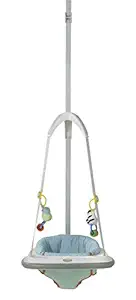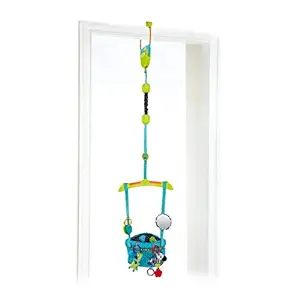Welcoming a baby into your home brings joy and a fair share of challenges, one of which is finding the perfect baby swing. A baby swing for the doorway can be a lifesaver for parents, offering a safe and entertaining space for their little one.
In this article, we will review the 7 best baby swings for doorways, focusing on their features, safety, and usability.
7 best baby swings for doorways
1. Graco Doorway Bumper Jumper

Features:
- Ease of Use: Simple clamp for door frame attachment.
- Comfort: Soft, all-around padding with adjustable straps.
- Entertainment: Includes interactive toys.
- Weight Limit: Up to 25 lbs.
Pros: Budget-friendly, portable.
Cons: Limited in terms of motion variety.
2. Fisher-Price Rainforest Jumperoo

Features:
- Design: Sturdy, free-standing frame.
- Comfort: Rotating seat for all-around play.
- Entertainment: Rainforest-themed toys.
- Weight Limit: Up to 25 lbs.
Pros: Enhances motor skills, no doorway needed.
Cons: Larger footprint, more expensive.
3. Evenflo ExerSaucer Doorway Jumper

Features:
- Ease of Use: Fits standard doorways easily.
- Safety: Fully-enclosed spring for added safety.
- Comfort: Adjustable straps for growing babies.
- Weight Limit: Up to 24 lbs.
Pros: Space-saving, secure attachment.
Cons: Lacks additional toys.
4. Bright Starts Bounce ‘N Spring Deluxe Door Jumper

Features:
- Comfort: High-back seat for additional support.
- Entertainment: Includes 4 repositionable toys.
- Safety: Sturdy door frame clamp.
- Weight Limit: Up to 26 lbs.
Pros: Comfortable, engaging for the baby.
Cons: Requires careful installation.
5. Baby Einstein Sea & Discover Door Jumper

Features:
- Design: Sea-themed toys for sensory development.
- Comfort: Padded seat ring for extra comfort.
- Ease of Use: Lightweight and easy to set up.
- Weight Limit: Up to 25 lbs.
Pros: Stimulates baby’s senses, easy to transport.
Cons: Less durable than some others.
6. Summer Infant Pop N’ Jump Portable Activity Center

Features:
- Portability: Compact fold for easy storage and travel.
- Comfort: Soft, jumping support seat.
- Entertainment: Includes toys and a sun canopy.
- Weight Limit: Up to 25 lbs.
Pros: Ideal for outdoor use, versatile.
Cons: Not strictly a doorway jumper.
7. Jolly Jumper Exerciser with Door Clamp

Features:
- Safety: Secure door clamp.
- Comfort: Scientifically designed saddle for correct posture.
- Portability: Easy to assemble and disassemble.
- Weight Limit: Up to 28 lbs.
Pros: Promotes coordination and balance.
Cons: No additional toys or activities.
Comparison Table
| Swing Model | Comfort | Entertainment | Weight Limit | Pros | Cons |
|---|---|---|---|---|---|
| Graco Doorway Bumper Jumper | High | Moderate | 25 lbs | Budget-friendly | Limited motion |
| Fisher-Price Rainforest Jumperoo | High | High | 25 lbs | Enhances motor skills | Larger, pricier |
| Evenflo ExerSaucer | Moderate | Low | 24 lbs | Secure, space-saving | No toys |
| Bright Starts Bounce ‘N Spring | High | High | 26 lbs | Engaging, comfortable | Installation care needed |
| Baby Einstein Sea & Discover | High | High | 25 lbs | Sensory development | Less durable |
| Summer Infant Pop N’ Jump | High | Moderate | 25 lbs | Portable, versatile | Not a doorway jumper |
| Jolly Jumper Exerciser | High | Low | 28 lbs | Aids coordination | No additional entertainment |
Important Note:
“When choosing a baby swing for the doorway, prioritize safety features like secure clamps and straps, comfort for your baby, and ensure it fits well in your home’s door frames. Also, adhere to the weight limits to prevent any accidents.”
Kind and Tips for Choosing the Perfect Baby Swing for Doorway
1. Assess the Safety Features
- Tip: Look for a baby swing with sturdy clamps and straps. Ensure it has a secure door frame attachment. Safety certifications from recognized organizations add an extra layer of trust.
2. Consider the Baby’s Comfort
- Tip: Choose a swing with a padded seat and adjustable features to grow with your baby. A comfortable seat design is crucial for your baby’s enjoyment and wellbeing.
3. Check the Weight and Age Limit
- Tip: Each swing has a specific weight and age limit. Select one that’s appropriate for your baby’s current stage and offers some room for growth.
4. Evaluate Ease of Installation and Use
- Tip: Opt for a swing that is easy to set up and dismantle. This makes it more convenient to move and store.
5. Look for Entertaining Features
- Tip: Swings with attached toys or playful designs can keep your baby engaged and stimulated. Consider if these toys are appropriate and safe for your baby’s age.
6. Portability Matters
- Tip: If you plan to move the swing around the house or take it on trips, look for a lightweight and portable model.
7. Consider the Space in Your Home
- Tip: Measure your doorways to ensure the swing fits. Some swings have a larger footprint, so consider the available space around the doorway.
8. Check for Adjustable Settings
- Tip: Adjustable height and swing speeds can help customize the experience for your baby’s comfort and mood.
9. Read Reviews and Recommendations
- Tip: Go through user reviews and expert recommendations to understand the pros and cons of different models.
10. Consider the Longevity of the Swing
- Tip: Invest in a swing that is durable and has a long lifespan, which can be beneficial if you plan to use it for future children.
11. Ease of Cleaning
- Tip: Look for a swing with removable and washable seat covers to maintain hygiene easily.
12. Budget Considerations
- Tip: Determine your budget beforehand but remember that the cheapest option might not always be the best in terms of quality and safety.
13. Look for Extra Features
- Tip: Some swings come with additional features like music, nature sounds, or vibration settings, which can be soothing for your baby.
14. Prioritize Your Baby’s Needs
- Tip: Every baby is different. Choose a swing that suits your baby’s preferences, whether it’s more motion, lights, or calmness.
15. Consult Pediatric Advice
- Tip: If your baby has specific needs, consulting with your pediatrician before purchasing a baby swing can be wise.
Frequently Asked Questions About Baby Swings for Doorways
1. What is the safe age range for using a baby swing for doorways?
- Most baby swings for doorways are suitable for babies from about 6 months old, when they can hold their head up unassisted, up to around 12-24 months, depending on the product’s weight limit.
2. How do I know if a baby swing is safe for my doorway?
- Ensure the swing is compatible with your doorway measurements and structure. Look for swings with secure, sturdy clamps and straps, and always adhere to the manufacturer’s installation guidelines.
3. Can baby swings for doorways cause developmental issues?
- Moderation is key. While doorway swings can be beneficial for sensory and motor development, excessive use may lead to dependency on motion for comfort. It’s essential to balance time in the swing with other activities.
4. What is the weight limit for most doorway baby swings?
- The weight limit varies, but most swings support between 20 to 30 pounds. Always check the specific weight limit of the swing you are considering.
5. Are baby swings for doorways portable?
- Many doorway swings are designed to be portable, allowing easy disassembly and transport. However, the level of portability can vary among different models.
6. How long can my baby safely stay in a doorway swing?
- Generally, it’s recommended to limit swing time to 20-30 minutes, and always under supervision. Prolonged periods can affect the baby’s comfort and posture.
7. Can I use a baby swing for a newborn?
- Doorway baby swings are not recommended for newborns as they require head and neck support. It’s best for babies who have gained head control, typically around 6 months old.
8. Do doorway baby swings come with entertainment features?
- Many models include toys, music, or lights to entertain the baby. However, features vary, so check the product details for specific entertainment options.
9. How much space do I need for a doorway baby swing?
- The required space can vary with each model. Generally, ensure ample space in front and behind the swing for safe swinging motion, and check the product’s dimensions.
10. Is it difficult to install a baby swing in a doorway?
- Most doorway baby swings are designed for easy installation, with clamps that attach to the door frame. Always follow the manufacturer’s instructions for safe installation.
11. Are doorway baby swings expensive?
- Prices vary based on features and brands. There are options available for various budgets, but it’s important to prioritize safety and quality over cost.
12. Can I adjust the height of the baby swing?
- Many baby swings offer adjustable height settings. Check the product specifications to ensure this feature is included.
13. How do I clean a doorway baby swing?
- Look for swings with detachable and washable seat covers. Follow the manufacturer’s instructions for cleaning to avoid damage.
14. Are baby swings for doorways safe for all types of door frames?
- Not all door frames are suitable for baby swings. Check the compatibility with your specific door frame type and the recommendations from the swing manufacturer.
15. Is it okay to leave my baby unattended in a doorway swing?
- It’s essential to always supervise your baby while in the swing to ensure safety and respond to their needs promptly.
These FAQs cover common concerns and considerations, helping parents make informed decisions about doorway baby swings.
Conclusion
In conclusion, the best baby swing for your doorway depends on your specific needs: whether it’s portability, entertainment, or budget. By considering these top picks, you can find a swing that not only soothes and entertains your baby but also fits well with your family’s lifestyle. Remember, always supervise your baby while using these swings to ensure their safety and well-being.